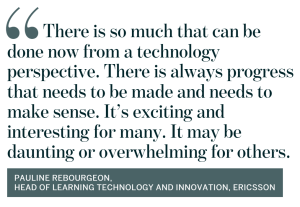When it comes to the use of technology in L&D, what does that refer to? How broad are we speaking? And how does it impact on the ground and strategically for the ever-changing workforce?
The most recent virtual HPC roundtable discussion encompassed the topic of technology and its role across organisations particularly in terms of development. Described according to a number of capacities and settling on the fact that it can have a plethora of interpretations, the talk was seamlessly facilitated by HPC’s Head of Research, Justin Kinnear to encourage a broad discussion. Justin prompted the raising of points pertaining to both the endless progress and ongoing challenges associated with implementing and adapting to different technologies.

Speakers Pauline Rebourgeon (Head of Learning Technology and Innovation, Ericsson) and Alan Reilly (Head of Talent Development, Version 1) offered varied insight and raised discussion with attendees through ongoing interaction including Q&A and breakout rooms. A panel of HR and Learning & Development professionals brought their own experiences of technology adoption with prompts from Justin, throughout.
Meeting needs for businesses and learners
Learning needs and environments are changing. This has brought forward challenges of bridging the gap.
Meeting the needs of the business and the learner have meant that there’s a new stepping up to happen. There has been an increased necessity to reassess and readapt and this is set to be ongoing. Businesses are increasingly holding L&D accountable for skill development. As a result, L&D Leaders are agilely straddling expectations. Learners are asserting themselves for flexibility and require ongoing change.

Hybrid working patterns have changed the social context of work and so, learning must be integrated seamlessly into online work. Learning must go where people live and meet them there. Meanwhile, there’s the balance of seeking human connection and finding new ways to stay motivated just as attention spans are shortening.
Experiments with different technologies
Start small, narrowly focus, experiment and don’t over-engineer it. These were the key factors to consider when the topic of facing challenges and implementing new technologies were up for discussion. A digital roadmap that incorporates various technologies was a common theme. Using a data-centric approach to drive adoption of those technologies is the factor that will increase the likelihood of acceptance by the business.
The changes that have come to the forefront have impacted the acceleration of flexible learning and creative modalities. The use of virtual reality, augmented reality and artificial intelligence have been main areas of testing by Pauline. Highlighting the significance of innovation, she highlighted that ‘we’ll never have it fully figured out’ thus encouraging the importance of trying and testing.
Career development and a system that enables the visibility and progression of individuals across the company has been a focus and success, according to Alan. Allowing individuals to have visibility over career paths means enabling them to map where they’re going and move out of silos.
Such experimenting with roadmaps has had a positive impact on global learning. As a result of COVID and the Pandemic, a virtual classroom became the norm. This change has led to ‘the breakdown of barriers and borders’. In companies with people from all over the world, this has enabled varied international learning. Where before, it was not always viable to bring them over here to Ireland, this has been a solution, according to Alan.
Working towards solutions
So, in what ways can these needs be met? And where are they needed most?
Onboarding in an organisation has a huge impact on retention and is a common discussion topic amongst professionals. By having a strong onboarding process, staff can build habits that support their confidence in the role and organisation. It gives them a strong sense of belonging and likelihood of staying. Being innovative in general and coming up with ways of making key decisions for the onboarding process is pivotal.

Another way of positively impacting retention is via career development pathing. According to LinkedIn’s 2018 Workplace Learning Report, 94% of employees surveyed said they would stay at a job longer if they were offered pathways for career development. This showed to be relevant in 2022 as it was raised in breakout rooms and in the wider group citing it as front of mind for L&D.
Key takeaways
When prompted for words that come to mind when connecting to the term ‘learning technologies’’, a broad range was used in the discussion. It is a topic that can envelop a mixture of tactics, strategy and is endlessly dynamic. Persistently revisiting, assessing needs from various angles and adapting are consistent themes in organisations. As for the role of technology in driving this forward? It’s an opportunity to experiment, understand and continue to revisit best practices. As the workplace changes, so too will the role of technology and how it can be utilised to best serve learning needs.

This discussion was part of our HPC Talks series – a small quarterly forum to discuss topics and issues relevant to the world of L&D. If you would like to be kept informed of future events, please contact fiona.claridge@wearehpc.com
HPC Talks Contributors
Pauline Rebourgeon

Pauline is Head of Learning Technology & Innovation at Ericsson, where she has been conducting experiments into using extended realities within the organisation. With more than 10 years of experience in the learning industry, she’s passionate about developing innovative and effective learning experiences. Prior to her role at Ericsson, she held L&D roles in Primark, Indeed.com and Novartis.
Connect with Pauline on LinkedIn >>>
Alan Reilly

Alan Reilly is a Head of Talent Development with 25+ years’ experience working within the IT Consultancy sector and Global Financial Services industry. His remit spans the areas of Talent Development, Early Careers, Organisational & Leadership Development, Succession Planning, Culture & Engagement, Performance Management, Human Resources and Talent Acquisition.
At the time of our event, Alan was Head of Talent Development at Version 1 and was leveraging collective intelligence technology to support the skills gap and development of the organisation’s technical workforce. He is now Learning & Development Manager at Mercury Engineering.
Connect with Alan on LinkedIn >>>
Justin Kinnear – HPC

Justin Kinnear is Head of Research at HPC. His passion for people development and his ability to inspire makes him a key member of HPC’s facilitation and coaching teams.
As well as his extensive research and facilitation experience, he was formerly Head of L&D at IBM and Britvic. His work with HPC focuses on the development of a high performance culture for our clients with a particular emphasis on accountability and feedback.